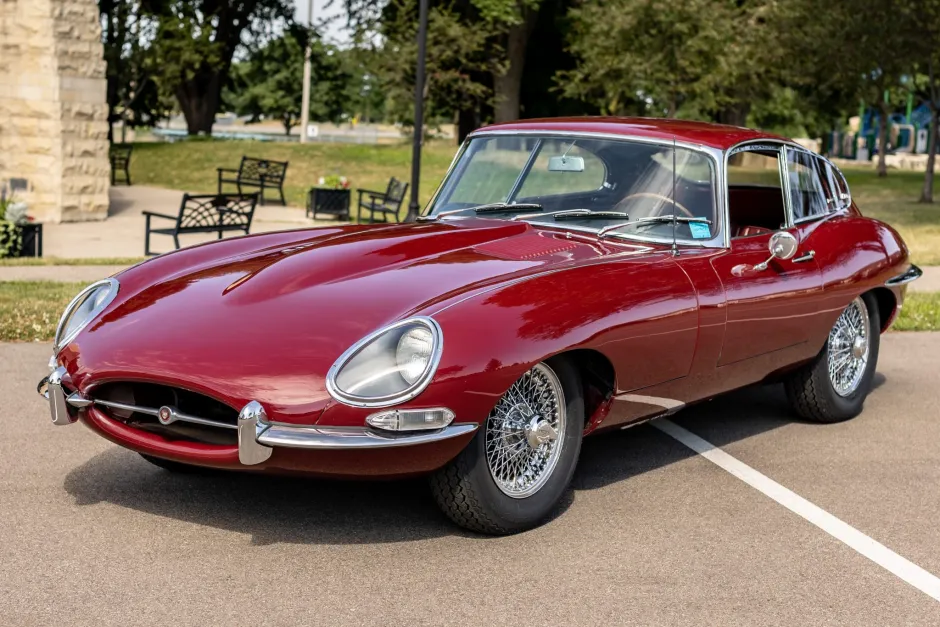
The 1966 Series I Jaguar E-Type: A Year of Evolution and Enduring Beauty
The 1966 Series I Jaguar E-Type, also known as the XK-E in the United States, represents a year of continued refinement and evolution for this iconic sports car. Additionally, building on the success and acclaim of its predecessors, the 1966 model year further solidified the E-Type’s status as a timeless classic. Furthermore, it captivated automotive enthusiasts with its breathtaking design, exhilarating performance, and engineering excellence.
Continuing Elegance and Timeless Design:
The 1966 Series I E-Type retained the iconic and sensuous design that made its predecessors automotive legends. Crafted by aerodynamicist Malcolm Sayer, the E-Type’s graceful curves, long bonnet, and distinctive front grille conveyed an air of elegance and performance. Its allure remained undiminished, firmly establishing the E-Type as a rolling work of art.
Performance and Powertrain Enhancements:
Under the bonnet, the 1966 Series I E-Type featured several performance enhancements. The heart of the car was the reliable and powerful 4.2-liter inline-six engine, first introduced in 1962. With 265 horsepower and ample torque, the E-Type offered exhilarating acceleration and an impressive top speed, making it a true sports car capable of thrilling driving experiences.
Improved Gearbox and Smooth Shifting:
For the 1966 model year, Jaguar refined the gearbox, providing smoother and more effortless gear changes. The fully synchronized transmission allowed for precise and enjoyable shifting, further enhancing the E-Type’s reputation as a true driver’s car.
Interior Comfort and Luxury:
Inside the 1966 Series I E-Type, Jaguar continued its dedication to providing a luxurious and comfortable driving environment. The cabin featured sumptuous leather upholstery, polished wood accents, and tastefully arranged instrumentation. These elegant touches complemented the car’s dynamic performance, creating a harmonious driving experience.
Advancements in Safety:
As safety standards advanced, the 1966 model year saw further improvements to the E-Type’s safety features. Jaguar enhanced the car’s braking system, providing even better responsiveness and stopping power. These enhancements contributed to the E-Type’s reputation for excellent handling and safety on the road.
Open-Top Roadster and Coupe Variants:
As in previous years, the 1966 Series I E-Type was available in both Roadster and Fixed Head Coupe (FHC) configurations. The Roadster’s convertible top offered the exhilaration of open-air driving, while the FHC provided a sense of refinement and comfort with its sleek fastback coupe design.
Continued Motorsport Success:
Additionally, the Series I E-Type’s motorsport success continued into the 1966 season, with privateer teams and drivers achieving victories in various prestigious races around the world. Furthermore, the E-Type’s prowess on the track solidified its reputation as a competitive and versatile sports car that excelled both on the road and in motorsport competitions.
Transatlantic Popularity and Recognition:
The Series I E-Type continued to enjoy significant popularity in the United States, where it was known as the XK-E. American buyers were enamored with the E-Type’s European elegance and high-performance capabilities, contributing to its success in the North American market.
Global Acclaim and Iconic Status:
By 1966, the Jaguar E-Type had become a globally recognized symbol of automotive excellence. Its striking design, thrilling performance, and competitive pricing made it a sought-after sports car among enthusiasts worldwide. The E-Type’s global acclaim further cemented its position as a motoring icon.
The Introduction of the Series 1 ½ E-Type:
As the 1960s progressed, Jaguar implemented subtle changes to the E-Type’s design and features. Leading to the introduction of the Series 1 ½ E-Type in 1967. The Series 1 ½ E-Type retained the aesthetics of the Series I but featured some mechanical updates and changes to meet new safety regulations.
Legacy and Collectibility:
The 1966 Series I Jaguar E-Type remains a highly coveted collector’s item and a true automotive icon. Its timeless design and exceptional engineering continue to captivate enthusiasts, collectors, and automotive historians alike. Pristine examples of the Series I E-Type fetch premium prices at prestigious classic car auctions, reflecting their desirability and collectibility.
Preservation and Restoration:
Dedicated enthusiasts and restorers are committed to preserving the authenticity and original character of the 1966 Series I E-Type. Meticulous restorations ensure that these automotive masterpieces continue to grace the roads and events of today, allowing new generations to appreciate and experience the allure of the Jaguar E-Type.
Conclusion:
Furthermore, the 1966 Series I Jaguar E-Type stands as a testament to Jaguar’s pursuit of automotive excellence. Additionally, its timeless design, exhilarating performance, and continuous refinements exemplify the brand’s commitment to producing extraordinary automobiles that transcend mere transportation.
Moreover, as an enduring symbol of automotive elegance and passion, the Series I E-Type continues to ignite the hearts of automotive enthusiasts worldwide. Furthermore, the 1966 model year marks yet another remarkable chapter in the E-Type’s storied history.
At Sell A Classic Car, we are classic Jaguar buyers in California. If you’re planning to sell your classic Jaguar, call us at (310) 399-3990 or email us at info@westcoastclassics.com to get the best deal in cash!
